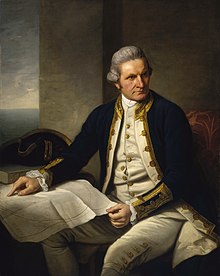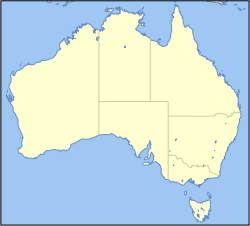Guugu Yimithirr language
This article includes a list of general references, but it lacks sufficient corresponding inline citations. (August 2015) |
| Guugu Yimithirr | |
|---|---|
| Pronunciation | [ˈkuːku ˈjɪmɪt̪ɪr] |
| Native to | Australia |
| Region | Hopevale, Queensland |
| Ethnicity | Guugu Yimithirr, Koko Njekodi |
Native speakers | 810 (2021 census)[1] |
| Dialects |
|
| Latin | |
| Language codes | |
| ISO 639-3 | kky |
| Glottolog | gugu1255 |
| AIATSIS[2] | Y82 Guugu Yimithirr, Y79 Guugu-Nyiguudyi |
| ELP | Guugu-Yimidhirr |
| Coordinates: 15°17′46″S 145°06′43″E / 15.29611°S 145.11194°E | |
Guugu Yimithirr, also rendered Guugu Yimidhirr, Guguyimidjir, and many other spellings, is an Australian Aboriginal language, the traditional language of the Guugu Yimithirr people of Far North Queensland. It belongs to the Pama-Nyungan language family.[3] Most of the speakers today live at the community of Hope Vale, about 46 kilometres (29 mi) from Cooktown. However, as of June 2020[update] only about half of the Guugu Yimithirr nation speak the language. As such, efforts are being made to teach it to children. Guugu Yimithirr is the source language of the word kangaroo (gangurru).[4]
Name
[edit]The word guugu means 'speech, language', while yimithirr (or yumuthirr) means yimi -having, yimi being the word for 'this'. The use of the word yi(mi), rather than some other word for "this", was seen as a distinctive feature of Guugu Yimithirr. The element guugu and the practice of naming based on some distinctive word is found in many other languages.
The name has many spelling variants, including Gogo-Yimidjir, Gugu-Yimidhirr, Gugu Yimithirr, Guugu Yimidhirr, Guguyimidjir (used by Ethnologue), Gugu Yimijir, Kukuyimidir, Koko Imudji, Koko Yimidir, Kuku Jimidir, Kuku Yimithirr, and Kuku Yimidhirr.
Geographic distribution
[edit]|
Location of the Guugu Yimithirr people |
The original territory of the Guugu Yimithirr tribe extended northwards to the mouth of the Jeannie River, where it was bordered by speakers of Guugu Nyiguudji; southwards to the Annan River, where it was bordered by speakers of Guugu Yalandji; to the west, it was bordered by speakers of a language called Guugu Warra (literally 'bad talk') or Lama-Lama. The modern town of Cooktown is located within Guugu Yimithirr territory.
As of the early 21st century, however, most Guugu Yimithirr speakers live at the mission at Hopevale.
Dialects
[edit]Guugu Yimithirr originally consisted of several dialects, although even the names of most have now been forgotten. Today, two main dialects are distinguished: the coastal dialect, called dhalundhirr 'with the sea', and the inland dialect, called waguurrga 'of the outside'.[5][6] Missionaries used the coastal dialect to translate hymns and Bible stories, so some of its words now have religious associations that the inland equivalents lack. There was once also a Ngegudi or Gugu Nyiguudyi dialect, which is unattested.[7]
History
[edit]
In 1770, Guugu Yimithirr became the first Australian Aboriginal language to be written down when Lieutenant (later Captain) James Cook and his crew recorded words while their ship, the HM Bark Endeavour, was being repaired after having run aground on a shoal of the Great Barrier Reef. Joseph Banks described the language as "totally different from that of the Islanders; it sounded more like English in its degree of harshness though it could not be called harsh neither [sic]".
Among the words recorded were kangooroo or kanguru (IPA: /ɡaŋuru/), meaning a large black or grey kangaroo, which would become the general English term for all kangaroos, and dhigul (transcribed by Banks as Je-Quoll), the name of the quoll.
Sydney Parkinson, who accompanied Cook, gave a useful word list in his posthumously published journal, A Journal of a Voyage to the South Seas.[8]
Phonology
[edit]Vowels
[edit]| Front | Back | |
|---|---|---|
| High | i iː | u uː |
| Low | a aː | |
Short /u/ may be realised as unrounded [ɯ], and unstressed /a/ may be reduced to [ə].
Consonants
[edit]| Peripheral | Laminal | Apical | ||||
|---|---|---|---|---|---|---|
| Bilabial | Velar | Palatal | Dental | Alveolar | Retroflex | |
| Stop | b | ɡ | ɟ | d̪ | d | ɖ |
| Nasal | m | ŋ | ɲ | n̪ | n | ɳ |
| Lateral | l | |||||
| Rhotic | r | ɻ | ||||
| Semivowel | w | j | ||||
The stops are usually voiceless and unaspirated initially and after short vowels, and voiced after consonants and long vowels.
The retroflexes [ɖ ɳ] may not be single phonemes, but clusters of /ɻd ɻn/. However, there is at least one word which, for older speakers, is pronounced with a word-initial retroflex: run, which is [ɖudaː] or [ɖuɖaː].
The rhotic /r/ is normally a flap [ɾ], but may be a trill in emphatic speech.
Phonotactics
[edit]All words, with the exception of a couple of interjections, begin with one consonant. The consonant can be a stop, nasal, or semivowel (that is, /l r ɻ/ do not occur initially).
Words can end in either a vowel or a consonant. The allowed word-final consonants are /l r ɻ j n n̪/.
Within words, any consonant can occur, as well as clusters of up to three consonants, which cannot occur initially or finally.
Grammar
[edit]Like many Australian languages, Guugu Yimithirr pronouns have accusative morphology while nouns have ergative morphology. That is, the subject of an intransitive verb has the same form as the subject of a transitive verb if the subject is a pronoun, but the same form as the object of a transitive verb otherwise.
Regardless of whether nouns or pronouns are used, the usual sentence order is subject–object–verb, although other word orders are possible.
The language is notable for its use of pure geographic directions (north, south, east, west) rather than egocentric directions (left, right, forward, backward),[9] though such "purity" is disputed.[10] Still, it has given its speakers a remarkable sense of direction.[citation needed]
Preservation
[edit]As of June 2020[update], only about half of the 1,400 Guugu Yimithirr people speak the language, with mostly only grandparents being fluent speakers. Hope Vale elders are helping to create video tutorials on teaching Guugu Yimithirr, which are being uploaded to YouTube, while the local school, Hope Vale Cape York Aboriginal Australian Academy, has a language program in its curriculum. With the schools closed and learning being done in the home, using the online videos, during the COVID-19 pandemic in Australia, adults as well as younger siblings have been learning the language alongside the schoolchildren.[4]
Vocabulary
[edit]Some words from the Guugu Yimithirr language, as spelt and written by Guugu Yimithirr authors include:[11]
- Balingga: echidna
- Birri: river
- Bubu: land
- Buurraay: water
- Gangurru: kangaroo
- Gulaan: possum
- Guuju: fish
- Jijirr: bird
- Munhu: grass
- Nanggurr: home/camp
- Ngalan: sun
- Thaarba: snake
- Wantharra nyundu? How are you?
References
[edit]- ^ Australian Bureau of Statistics (2021). "Cultural diversity: Census". Retrieved 13 October 2022.
- ^ Y82 Guugu Yimithirr at the Australian Indigenous Languages Database, Australian Institute of Aboriginal and Torres Strait Islander Studies (see the info box for additional links)
- ^ "Guugu Yimidhirr « Sorosoro". Sorosoro.org. Retrieved 15 August 2015.
- ^ a b Mounter, Brendan (17 June 2020). "Hope Vale elders using modern platform as latest tool to preserve ancient Guugu Yimithirr language - ABC News". ABC (Australian Broadcasting Corporation). Retrieved 17 June 2020.
- ^ "Y167: Dhalundhirr". Australian Indigenous Languages Database. Australian Institute of Aboriginal and Torres Strait Islander Studies. 26 July 2019. Retrieved 10 June 2022.
- ^ "Y168: Waguurrga". Australian Indigenous Languages Database. Australian Institute of Aboriginal and Torres Strait Islander Studies. 26 July 2019. Retrieved 10 June 2022.
- ^ "Y79: Guugu-Nyiguudyi". Australian Indigenous Languages Database. Australian Institute of Aboriginal and Torres Strait Islander Studies. 26 July 2019. Retrieved 10 June 2022.
- ^ "Parkinson's Journal, New Holland, page 191". Southseas.nla.gov.au. Retrieved 15 August 2015.
- ^ Deutscher, Guy (26 August 2010). "Does Your Language Shape How You Think?". The New York Times.
- ^ Haviland, John B. (March 1998). "Guugu Yimithirr Cardinal Directions" (PDF). Ethos. 26 (1): 25–47. doi:10.1525/eth.1998.26.1.25.
- ^
 This Wikipedia article incorporates text from Guugu Yimithirr published by the State Library of Queensland under CC BY licence, accessed on 10 June 2022.
This Wikipedia article incorporates text from Guugu Yimithirr published by the State Library of Queensland under CC BY licence, accessed on 10 June 2022.
General references
[edit]- Banks, Joseph (1962). J. C. Beaglehole (ed.). The Endeavour journal of Joseph Banks, 1768-1771.
- Breen, Gavan (1970). "A re-examination of Cook's Gogo-Yimidjir word list". Oceania. 41 (1): 28–38. doi:10.1002/j.1834-4461.1970.tb01113.x.
- Cook, James (1955). The Journals of Captain James Cook. Cambridge: Cambridge University Press. ISBN 0-665-35756-7.
- Dixon, R. M. W. (2002). Australian Languages: Their Nature and Development. Cambridge: Cambridge University Press. ISBN 0-521-47378-0.
- Haviland, John B. (1974). "A last look at Cook's Guugu-Yimidhirr wordlist". Oceania. 44 (3): 216–232. doi:10.1002/j.1834-4461.1974.tb01803.x.
- Haviland, John B. (1979). "Guugu Yimidhirr Sketch Grammar". In R. M. W. Dixon and B. Blake (ed.). Handbook of Australian Languages Vol I. pp. 26–180.
- Haviland, John B. (1985). "The life history of a speech community: Guugu Yimidhirr at Hopevale". Aboriginal History. 8 (7): 170–204.
- Richard Phillips; Sidney H. Ray (1898). "Vocabulary of Australian Aborigines in the neighbourhood of Cooktown, North Queensland". The Journal of the Anthropological Institute of Great Britain and Ireland. 27. Royal Anthropological Institute of Great Britain and Ireland: 144–147. doi:10.2307/2842861. JSTOR 2842861.
- Roth, Walter E. (1901). The structure of the Koko-Yimidir language. Brisbane: Government Printer.
- Schwarz, G. H. (1946). Order of service and hymns. Brisbane: Watson, Ferguson.
- de Zwaan, Jan Daniel (1969). A preliminary analysis of Gogo-Yimidjir. Canberra: Australian Institute of Aboriginal Studies.
- de Zwaan, Jan Daniel (1969). "Two studies in Gogo-Yimidjir". Oceania. 39 (3): 198–217. doi:10.1002/j.1834-4461.1969.tb01006.x.
External links
[edit]- Guugu Yimithirr exercises (page 2).
- Does Your Language Shape How You Think? (NYT)
- Bibliography of Guugu Yimidhirr people and language resources Archived 17 April 2016 at the Wayback Machine, at the Australian Institute of Aboriginal and Torres Strait Islander Studies
- Guugu Yimidhirr (Cooktown) community language journey digital story, State Library of Queensland. Part of Spoken: Celebrating Queensland Languages Digital Stories Collection
- Guugu Yimidhirr (Hope Vale) community language journey digital story, State Library of Queensland. Part of Spoken: Celebrating Queensland Languages Digital Stories Collection


